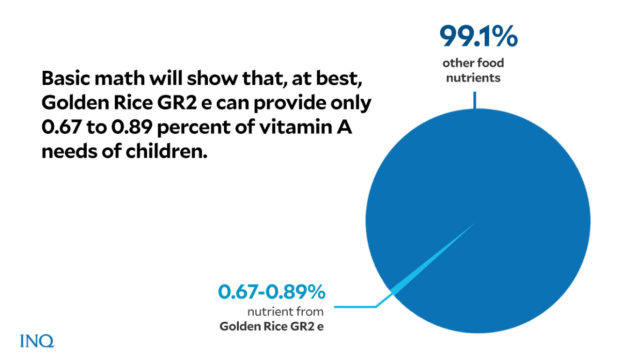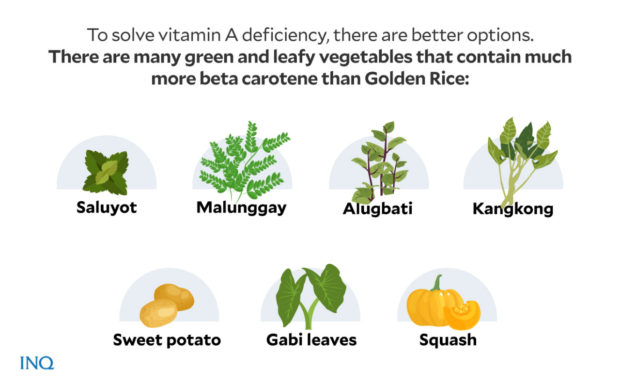Golden Rice’s lies: It will not be a cure for vitamin A deficiency in children

International Rice Research Institute bioplant scientist Sophan Datta shows to the press a variety of experimental “golden rice” being tested inside sealed IRRI greenhouse in Laguna. (AFP)
Proponents of the genetically modified crop Golden Rice claim that vitamin A deficiency in the Philippines was prevalent.
In the Philippines alone, more than 3 million children suffer from vitamin A deficiency.
Vitamin A is vital for infants and children as it is essential for rapid growth and helps combat infections.
There are many causes of vitamin A deficiency and they include:
- Not eating enough food with vitamin A
- Lack of fat or oil intake that helps the body absorb vitamin A
- No breast feeding as mother’s milk is rich in vitamin A
The current version of Golden Rice contains vitamin A and can provide 30 to 50 percent of vitamin A requirements of children, according to Golden Rice proponents. But is this claim true?
The main weakness of this claim is that the amount of rice that contains enough doses of vitamin A has not been specified. Why? Is it because total carotenoid (substance rich in vitamin A) content of Golden Rice is very low?
Some Golden Rice varieties contain only 3.6 parts per million (ppm) to 6.2 parts per million of vitamin A. Another variety contains an 3.1 ppm to 6.4 ppm. The average vitamin A content for two varieties is 4.825 ppm.
What does this total carotene content mean?
Consider this: Children between the age of one and 9 years old have recommended energy intake of 1,266 kilocalories per day. Assuming that 50 percent of that comes from rice, this would translate to 633 kcal per day or about 166.79 grams of rice per day.
The average total carotene content of selected Golden Rice varieties is 4.825 ppm or 4.825 microgram per gram. If a child eats 166.79 grams of rice a day, the total carotene intake would only be 804.76 micrograms per day or just 0.80476 milligram.
A 2017 study by Combs&McClung described how vitamin A must be reported. For reporting vitamin A activity, retinol equivalents are to be used.
If we are to use that, the retinol equivalents of a variety of Golden Rice is only 0.21 RE to 0.402 RE. This is based on the assumption that total carotene, referred to in the Golden Rice variety, contains large amount of beta carotene, which is not the case as total carotene included other compounds.
Children between five and eight years old need to consume between 90 to 120 mg of beta carotene per day.
If they are to get their vitamin A from rice, and they consume only 166.79 grams of rice a day, their total carotene intake is only 0.67 percent to 0.89 percent relative to what they need. This means that they have to eat 18.74 to 24.894 kilos of rice daily to satisfy their beta carotene requirement.
But beta carotene and other carotenoids provide about 50 percent of vitamin A. In such a case, children between the ages of five and eight years old should have rice intake of 37.48 kilos to 57.788 kilos of rice per day. No human being, more so children, can eat that much rice.
If we are to use again Combs &McClung’s way of reporting vitamin A into retinol equivalents (RE), the retinol equivalents of the Golden Rice variety GR2e is only 0.21 RE to 0.402 RE.
For children, the carotenoid content of Golden Rice must be reported as vitamin A and to be useful, this must be converted into retinal equivalents, or RE.
According to another study in 2021: “Most of the dietary vitamin A is of plant origin in the form of provitamin A that is converted into vitamin A in the body.”
Golden Rice proponents knew all along that the units they should be using in their paper should be vitamin A. Why? This is because of their claim that the current Golden Rice variety had significant amounts of carotenoid in milled grains. These can supply 30 to 50 percent of estimated average requirement of vitamin A.
But our calculations showed that children should eat 64.235 kilos to 89.44 kilos of Golden Rice in one day. That amount would already be their one-year consumption. It goes without saying that Golden Rice variety, though containing beta carotene, cannot be used to treat vitamin A deficiency.
It should be noted, too, that we did not consider the dissipation of carotenoid during storage and cooking. This was not considered in the calculations.
It is obvious that the claim that Golden Rice, or the GR2 e variety, could solve vitamin A deficiency is so far from reality.
On the claim that it can provide 30 to 50 percent of carotene requirements of children, this is. not supported by calculations.
Basic math will show that, at best, Golden Rice GR2 e can provide only 0.67 to 0.89 percent of vitamin A needs of children. The claim that it can solve vitamin A deficiency among children is cheap, fraudulent and the height of dishonesty, to say the least.
And it also misleads the public. If the claim is true or precise, can they swear under oath and have this claim notarized? They have not that yet.
The logical thing to do is for them to stop promoting Golden Rice as a solution to vitamin A deficiency.
Proponents should go back to the drawing board. Bill Gates Foundation is the financing Golden Rice. He should summon all researchers to explain their data and claims.
People should know the truth.
To solve vitamin A deficiency, there are better options. There are many green and leafy vegetables that contain much more beta carotene than Golden Rice like saluyot, malunggay, alugbati, gabi leaves, kangkong, squash or orange sweet potato tuber.
Golden rice claims to have 3.57 to 4.82 microgram per gram of beta carotene. But saluyot has 60, malunggay has 67, alugbati has 38, gabi leaves have 58, kangkong has 76, squash has 46 and orange sweet potato tuber has a whopping 200.
Compared to rice, their relative beta carotene contents are many more times higher than Golden Rice. But Golden Rice proponents will ask: If this is so, why is vitamin A deficiency prevalent?
The reasons are obvious. One, Filipinos in general are not veggie eaters. Our average intake of vegetable is just 30 kilos per capita. It might have increased this time because of the pandemic. No data are available yet. Two, growing vegetables, even in backyards, is not regularly done by farmers whose children are often malnourished.
Our alternative should be to promote planting vegetables by providing seeds or planting materials. Instead of using millions of pesos in research and development for Golden Rice, it will be more cost-effective, efficient and faster to address vitamin A deficiency by promoting the planting of green, leafy vegetables.
This should be launched in every village nationwide.
Consuming malunggay, alugbati, squash, etc will address not only vitamin A deficiency but these could also provide many other nutrients needed by the body, especially if these vegetables are grown organically. They give both health and environmental benefits. They help boost immune systems that are so necessary in fighting COVID-19.
(Editor’s note: Teodoro C. Mendoza is a retired professor of Institute of Crop Science at the College of Agriculture and Food Sciences, UP Los Banos. He is an advocate and practitioner of household-based food garden and small-scale biodiverse organic farming)


